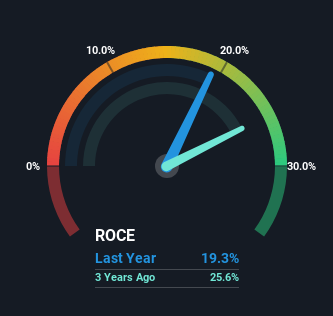- India
- /
- Commercial Services
- /
- NSEI:MALLCOM
Mallcom (India) (NSE:MALLCOM) Will Be Hoping To Turn Its Returns On Capital Around
What trends should we look for it we want to identify stocks that can multiply in value over the long term? Typically, we'll want to notice a trend of growing return on capital employed (ROCE) and alongside that, an expanding base of capital employed. Ultimately, this demonstrates that it's a business that is reinvesting profits at increasing rates of return. However, after briefly looking over the numbers, we don't think Mallcom (India) (NSE:MALLCOM) has the makings of a multi-bagger going forward, but let's have a look at why that may be.
Understanding Return On Capital Employed (ROCE)
Just to clarify if you're unsure, ROCE is a metric for evaluating how much pre-tax income (in percentage terms) a company earns on the capital invested in its business. The formula for this calculation on Mallcom (India) is:
Return on Capital Employed = Earnings Before Interest and Tax (EBIT) ÷ (Total Assets - Current Liabilities)
0.19 = ₹514m ÷ (₹4.4b - ₹1.7b) (Based on the trailing twelve months to September 2024).
Thus, Mallcom (India) has an ROCE of 19%. On its own, that's a standard return, however it's much better than the 15% generated by the Commercial Services industry.
View our latest analysis for Mallcom (India)

Historical performance is a great place to start when researching a stock so above you can see the gauge for Mallcom (India)'s ROCE against it's prior returns. If you'd like to look at how Mallcom (India) has performed in the past in other metrics, you can view this free graph of Mallcom (India)'s past earnings, revenue and cash flow.
So How Is Mallcom (India)'s ROCE Trending?
On the surface, the trend of ROCE at Mallcom (India) doesn't inspire confidence. Over the last five years, returns on capital have decreased to 19% from 26% five years ago. Meanwhile, the business is utilizing more capital but this hasn't moved the needle much in terms of sales in the past 12 months, so this could reflect longer term investments. It's worth keeping an eye on the company's earnings from here on to see if these investments do end up contributing to the bottom line.
On a side note, Mallcom (India) has done well to pay down its current liabilities to 39% of total assets. That could partly explain why the ROCE has dropped. What's more, this can reduce some aspects of risk to the business because now the company's suppliers or short-term creditors are funding less of its operations. Some would claim this reduces the business' efficiency at generating ROCE since it is now funding more of the operations with its own money.
Our Take On Mallcom (India)'s ROCE
To conclude, we've found that Mallcom (India) is reinvesting in the business, but returns have been falling. Although the market must be expecting these trends to improve because the stock has gained 37% over the last year. However, unless these underlying trends turn more positive, we wouldn't get our hopes up too high.
Mallcom (India) does have some risks though, and we've spotted 1 warning sign for Mallcom (India) that you might be interested in.
If you want to search for solid companies with great earnings, check out this free list of companies with good balance sheets and impressive returns on equity.
New: Manage All Your Stock Portfolios in One Place
We've created the ultimate portfolio companion for stock investors, and it's free.
• Connect an unlimited number of Portfolios and see your total in one currency
• Be alerted to new Warning Signs or Risks via email or mobile
• Track the Fair Value of your stocks
Have feedback on this article? Concerned about the content? Get in touch with us directly. Alternatively, email editorial-team (at) simplywallst.com.
This article by Simply Wall St is general in nature. We provide commentary based on historical data and analyst forecasts only using an unbiased methodology and our articles are not intended to be financial advice. It does not constitute a recommendation to buy or sell any stock, and does not take account of your objectives, or your financial situation. We aim to bring you long-term focused analysis driven by fundamental data. Note that our analysis may not factor in the latest price-sensitive company announcements or qualitative material. Simply Wall St has no position in any stocks mentioned.
About NSEI:MALLCOM
Mallcom (India)
Engages in the manufacture and sale of personal protective equipment in India and internationally.
Proven track record with adequate balance sheet.
Similar Companies
Market Insights
Community Narratives




